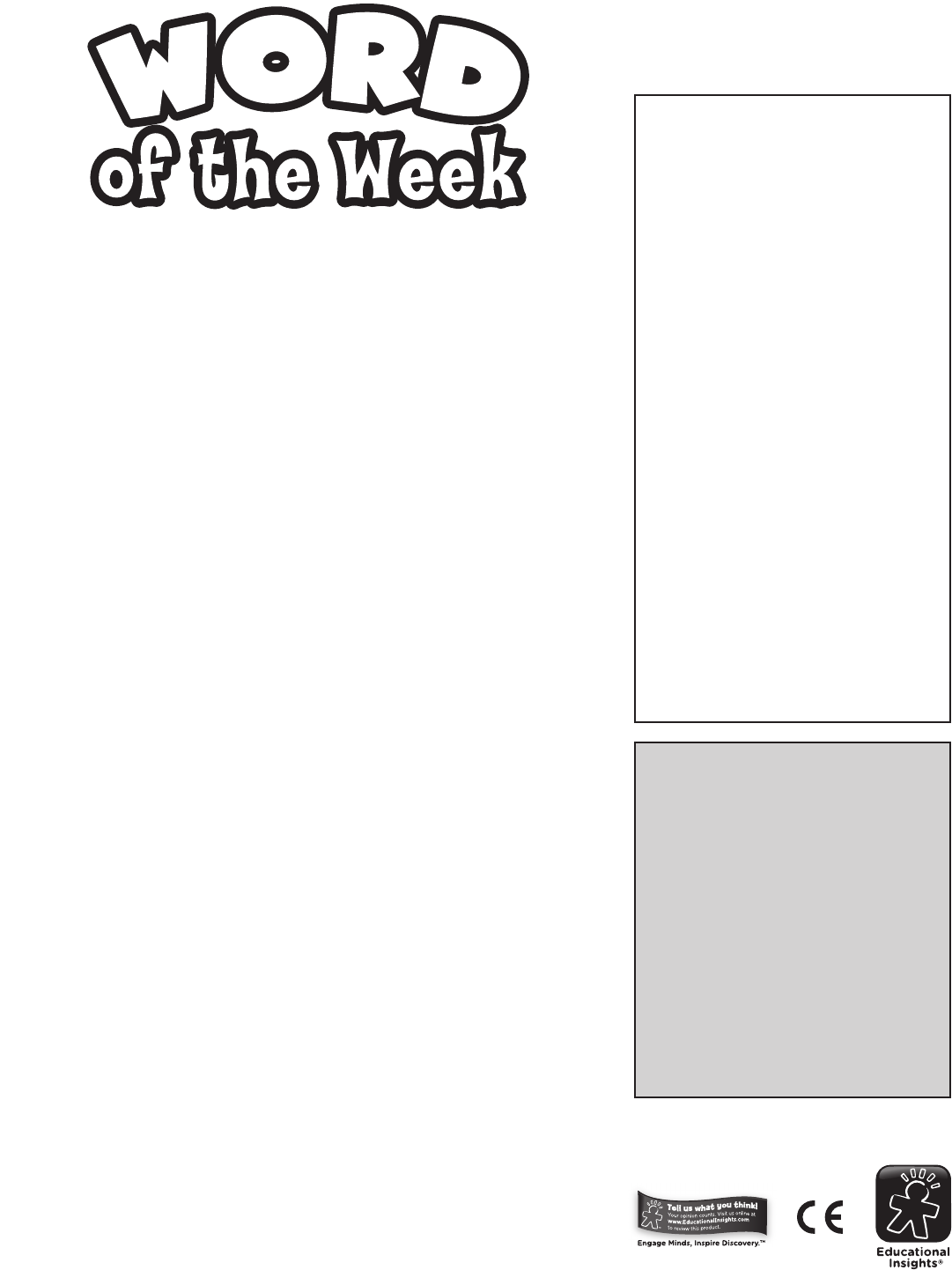
G R A D E S 3 – 4
Build students’ writing, speaking, and test-taking vocabularies week-by-week
with this fun vocabulary development program with a twist – appealing,
large-format cartoons that students will laugh about and remember!
Using the Word of the Week Program
Designate a set time at the beginning of the week for introducing each
Word of the Week. Separate the target word, its definition, and the cartoon
along the perforated edges. (Note: The words, definitions, and cartoons
are all numbered to make keeping them together easy.) Display them in
the pockets, leaving room at the bottom for student-written sentences.
Discuss each word, including its part of speech, definition, and use in the
cartoon. Have each student write a sentence using the target word in class
or as a homework assignment. Focus on the word, using some of the tips
below, for a week. When you are done, store the materials in the handy
storage pocket on the back.
Tips
Here are some ways to review the target Word of the Week:
• Post and discuss a new student-written sentence each day.
• Keep a tally on the board each time the word is used appropriately
during the school day.
• Have students bring in and share newspaper headlines or sentences they
have copied from books or magazines in which the target word is used.
• Add the target word to your weekly spelling test as extra credit.
• Create a word wall by writing each new word on a sentence strip and
posting it. This attention-getting visual display will remind students to
use their new vocabulary words in their everyday speech and writing.
Students can also add synonyms below the words as they think of
them during the week.
• Have students copy the word and its definition onto opposite sides
of an index card. By the end of the year, students will have a library
of vocabulary flash cards.
Using the Reproducible Pages
We have included a quiz or activity for each group of ten words. The
quizzes can be used for both pre- and post test assessment. In addition,
we have included a Make-Your-Own Cartoon page. Having students create
their own cartoons for the target words in the program is an excellent
way of checking and reinforcing their understanding of word meanings.
You may also have students choose words from their reading to illustrate.
Display the cartoons or make copies and bind them into a book for your
classroom library, or submit them to the school newsletter.
Here are some tips to inspire your budding cartoonists:
• Make it autobiographical.
• Use historical or storybook characters in unexpected situations.
• Give people ridiculous super powers or give animals abilities they
wouldn’t normally have.
EI-1750
Grades 3-4
A
ges 8-9
Word List
The 40 words in the program are
i
ntroduced in the following order:
strive
immense
abode
ponder
wallop
culprit
blunder
eerie
heed
utter
attire
superb
sliver
baffle
taunt
murmur
hasty
shriek
jovial
lug
hurl
irate
dingy
tranquil
pact
drowsy
flawless
prank
throng
plead
thorough
jostle
timid
amble
bedlam
jaunt
scrumptious
flaunt
slumber
feign
Answer Key
Quiz 1
1. c, 2. c, 3. d, 4. a, 5. b,
6. d, 7. a, 8. d, 9. b, 10. a
Quiz 2
1. c, 2. d, 3. f, 4. h, 5. g,
6. e, 7. j, 8. b, 9. a, 10. i
Quiz 3
1. throng, 2. hurl, 3. flawless, 4. prank,
5. irate, 6. dingy, 7. tranquil, 8. plead,
9. drowsy, 10. pact
Quiz 4
Across: 2. slumber, 5. amble, 7. feign,
8. timid, 9. thorough
Down: 1. jostle, 2. scrumptious,
3. jaunt, 4. flaunt, 6. bedlam
© Educational Insights, Inc., Gardena, CA (U.S.A.).
All rights reserved. Learning Resources Ltd., King’s
Lynn, Norfolk (U.K.). Made in China. Please retain
this information.
© Illustrations copyright by Marc Tyler Nobleman.
